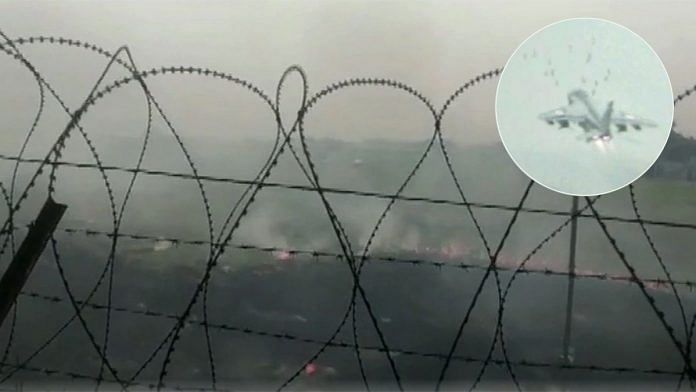New Delhi: A spate of bird-hit incidents at major air bases have alarmed the Indian Air Force, so much so that it has filed a complaint with the local district administration of Ambala in Haryana about the increasing population of pigeons bred near the base.
Ambala is one of IAF’s frontline bases which played an active role during the Kargil conflict as the Mirage 2000s were deployed from there. In peace time it houses the Jaguar strike aircraft and the MiG-21 Bisons. More importantly, the first batch of the Rafale fighters will be based in Ambala.
In June this year, the base got a scare when a Jaguar aircraft suffered engine failure due to a bird-hit soon after take-off but managed to land safely by jettisoning its additional fuel tanks. The IAF’s worry, however, is not just limited to Ambala or the Rafales as the force is also expecting to induct upgraded aircraft in the coming months.
A sizeable problem
Last week, a Sukhoi Su-30 MKI was not so lucky in Jodhpur in neighbouring Rajasthan as it suffered major damage after a bird-hit. In fact, the Jodhpur base alone has registered 53 bird-hit cases in five years, of which nine were reported just this year.
Since 2017, the Gwalior air base has seen three bird-hits, as has the Pune air base. The Tezpur base in Assam has witnessed two incidents, while there has also been one at the Hasimara base in West Bengal.
Bird-hits contribute to about 10 per cent of the accidents faced by fighter aircraft — between April 2011 and March 2014, military pilots reported 504 such incidents. While the IAF refused to share latest consolidated numbers for bird-hits across the country, sources in the force said the problem remains a major concern.
The IAF relies on zone guns and crackers to scare away birds. India had plans to procure 45 bird-detection radars for the IAF and the Navy, but that never materialised. The tender to procure the radars at a cost of Rs 250 crore was cancelled by the government in 2015 when four firms were competing for the order.
Also read: F-16 never stood a chance to be in IAF fleet. Lockheed Martin messed it up so much
Reasons for bird hits
IAF sources told ThePrint that the main reasons for bird-hits include improper garbage disposal, rearing of pigeons and also random movement of birds due to change in weather and altered topography of water bodies.
Government notifications state that there cannot be any civilian construction within 900 metres of the weapon storage area, many of which are located inside airfields, or 100 metres from the boundary of the air base.
“But over the years, population has encroached on the space very close to airfields,” one IAF officer said, adding that at times, political pressure doesn’t let the civilian administration take any action against such encroachment.
In the past, the IAF has taken up initiatives such as setting up an ornithology cell where specialists study bird patterns; liaising regularly with the Ministry of Housing and Urban Affairs for better implementation of Swachh Bharat, and with surrounding villages for proper garbage disposal; and using DNA bar-coding technology to identify the species of birds mostly involved in bird hits.
“Long-term insect studies are also carried out at select bases, and a dog-walking module is followed, where dogs scare away birds that breed near the runway and cross over,” a source said.
“However, most initiatives taken by the IAF are effective only inside the air base. Outside, the IAF is dependent on the goodwill of the civilian population. Most bird hits take place in the take-off or landing path outside the base.”
Also read: Kargil’s little-known fact: How IAF used helicopters to target intruders at high altitudes
Bird-hits haven’t been taken seriously enough
Retired officers of the IAF such as Air Vice Marshal Sunil Nanodkar say not enough seriousness has been shown to prevent bird hits, particularly those caused by migratory birds.
“First, there is a problem of manpower — not enough manpower is available at the air bases to monitor bird activities. Then, an inadequate defence budget forces the services to prioritise, and procuring avian radars is pushed down the priority list,” he said.
Nanodkar pointed out that even civilian airports don’t have such radars, which “should be made compulsory since they contribute to aviation safety”.
He said equipment like zone guns becomes redundant after some time as birds get used to them. “Distress calls of local birds are also played to prevent birds from coming on the flight path of the aircraft,” he said.
Former Vice-Chief of Air Staff, Air Marshal P.K. Barbora (retd) added that although bird-hits happen all over the world, things are worse in India because of a lack of general cleanliness. He emphasised that Swachh Bharat needs to progress “beyond the 5 per cent it has done till now”.
“In the last 30 years, technology has improved and the aircraft are more robust at tackling bird-hits. But when a flock of birds the size of a kite hits the engine of an aircraft and blocks the movement of air, it is difficult to save the aircraft,” Barbora said.
He pointed out that bird-hits were the crucial reason why regular fighter operations were stopped from the Hindon air base near Delhi decades ago.
Also read: Dassault Aviation likely to start making Rafale parts in India this year for global clients



